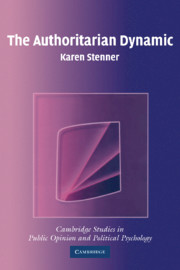Book contents
- Frontmatter
- Contents
- List of Tables
- List of Figures
- Acknowledgments
- 1 Introduction: The Authoritarian Dynamic
- 2 Kindred Spirits, Common Spark: The Theory of the Authoritarian Dynamic
- 3 Manipulating Threat and Reassurance: Data and Methods
- 4 The Authoritarian Dynamic and the Politics of Fear: Putting the Pieces of the Puzzle Together
- 5 Authoritarianism and Conservatism across Cultures
- 6 Authoritarianism and Conservatism: How They Differ and When It Matters
- 7 One True People: Putting a Face on the Theory
- 8 One Right Way: Fleshing Out the Portrait
- 9 Manning the Barricades: Racism and Intolerance under Conditions of Normative Threat
- 10 The Authoritarian Dynamic: Implications
- Bibliography
- Index
- Titles in the series
3 - Manipulating Threat and Reassurance: Data and Methods
Published online by Cambridge University Press: 05 June 2012
- Frontmatter
- Contents
- List of Tables
- List of Figures
- Acknowledgments
- 1 Introduction: The Authoritarian Dynamic
- 2 Kindred Spirits, Common Spark: The Theory of the Authoritarian Dynamic
- 3 Manipulating Threat and Reassurance: Data and Methods
- 4 The Authoritarian Dynamic and the Politics of Fear: Putting the Pieces of the Puzzle Together
- 5 Authoritarianism and Conservatism across Cultures
- 6 Authoritarianism and Conservatism: How They Differ and When It Matters
- 7 One True People: Putting a Face on the Theory
- 8 One Right Way: Fleshing Out the Portrait
- 9 Manning the Barricades: Racism and Intolerance under Conditions of Normative Threat
- 10 The Authoritarian Dynamic: Implications
- Bibliography
- Index
- Titles in the series
Summary
Most of the empirical investigations to follow draw upon three different data collections – the Durham Community Survey 1997 (DCS97), the Multi-Investigator Study 1999 (MIS99), and the Cultural Revolution Experiment 1995 (CRE95) – for which I was fortunate to be among the original investigators. Thus in each case I had the opportunity to include a tremendous array of variables (including many original instruments as well as variables infrequently measured on standard social science surveys) and to embed a number of experimental manipulations, all specifically designed to test my hypotheses (see Sniderman et al. 1991 for a discussion of the advantages of this approach). Each dataset employed in this work has its own corresponding appendix, providing full details and exact descriptions of data collection, variable measurement, and scale construction, as well as univariate statistics and the complete results of analyses. These appendices (lettered A1, A2, A3, B, C, D, and E) do not appear here in the hard copy due to space limitations, but may be found online on the worldwide web at 〈www.KarenStenner.com〉. Tables and figures that are numbered appear in the corresponding chapters in the text (e.g., Table 5.1 appears in Chapter 5), while tables and figures that are lettered can be found on the website in their respective appendices (e.g., Figure B.3 can be found in Appendix B).
- Type
- Chapter
- Information
- The Authoritarian Dynamic , pp. 37 - 51Publisher: Cambridge University PressPrint publication year: 2005



